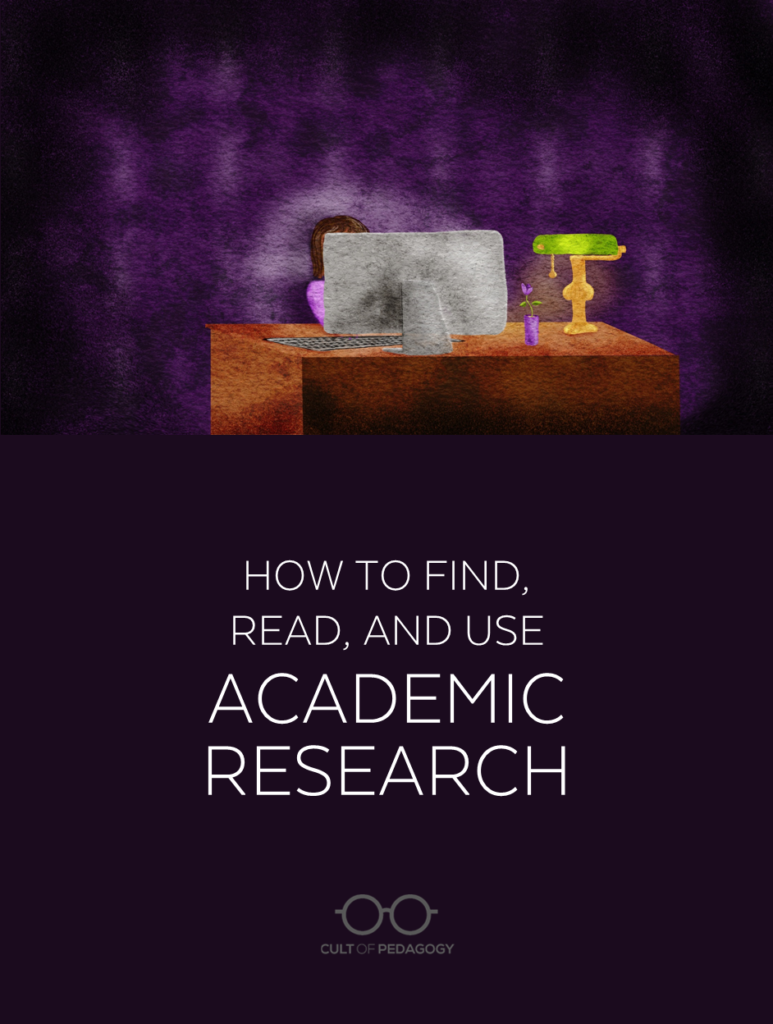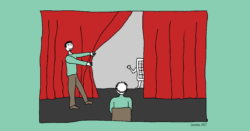
Listen to the interview with Dr. Kripa Sundar (transcript):
Sponsored by simpleshow and ISTE
This post contains Amazon Affiliate links. When you make a purchase through these links,
Cult of Pedagogy gets a small percentage of the sale at no extra cost to you.
When I put things out into the world about teaching, I do my best to support those things with research. But honestly, I’ve never felt really secure about it, because I don’t have any formal training in academic research. I have a Bachelor’s degree in secondary education and an M.A. in writing and publishing, so my direct experience with academic research has been mostly self-directed.
Although plenty of people in the education world do have this training, I’m guessing quite a few others—especially K-12 classroom teachers— are in a similar boat to mine: You have a vague understanding of how a peer-reviewed, published piece of research works, but a lot of it is still pretty confusing. It’s like the university folks who study best teaching practices are standing at the edge of a canyon and all the way on the other side are the actual practicing teachers. There should be steady, clear communication between these two groups—lots of good bridges that are easy to access—but so far we only have a few, and far too many of us on the teaching side don’t even know about them.
That’s what this post is for: to teach teachers how to get ahold of research that can inform what you do in your classroom, hopefully in ways that won’t require crazy amounts of time.
My guest, Dr. Kripa Sundar, is an educational psychologist who agreed to help me get better at understanding how to read research. After talking about some of the excellent publications that are out there that already summarize this research for us, she then walks me through how to find the actual research, then shows me how to read a meta-analysis and a sample study.
Because what Dr. Sundar taught me was highly visual, especially the second half, I have produced it as a 6-part series on YouTube. The last three videos, which are the most visual, are embedded below.

Start with Good Summary Publications
Before you spend a lot of time looking for single, specific studies to answer your research questions, start by making use of all the research summaries that are already out there.
- The What Works Clearinghouse, backed by the U.S. Department of Education, offers a fantastic collection of resources to help educators make research-based decisions. Visitors can compare the effectiveness of various practices, and download practice guides that summarize key research findings, sorted by area of interest. This video offers an overview of everything you can find on the site.
- American Educator is a free quarterly journal of the American Federation of Teachers, publishing peer-reviewed, research-based articles on a wide range of education-related topics. Each article goes in-depth on a topic like this one on community schools, summarizing and synthesizing relevant research, and offering robust reference lists so readers can follow up on individual studies.
- Handbooks like those from Routledge and Cambridge offer overviews of research on hundreds of topics.
- Books. Although these may not be the best source for finding an answer to one specific research question, they’ll give you a good foundation in the general practices that are supported by research:
- Blogs that do a good job of regularly incorporating solid research into their posts:
- Initiatives like TLRC, ResearchED, and Deans for Impact work to disseminate research more effectively.
Things to Keep in Mind About Research
When dealing with any kind of research, Sundar cautions educators to keep the following caveats in mind:
- Research is an ongoing process. “As you collect more data, the evidence can suggest other things,” Sundar explains. “So what once we said, hey, this works, maybe in a decade or five years or 20 years we’re saying, that doesn’t work. That doesn’t discount the value of research in its whole. It’s a mere factor of how education research happens: We work with students who are living beings in real times of changing context. So as we collect data from these folks, they’re going to show us different sets of data.”
- Research is done by humans. “There will always be inherent bias,” Sundar says. So always take the results with a grain of salt.
- There are no silver bullets. Even if something worked in a study, “it’s going to be in very controlled setting,” Sundar cautions. That doesn’t mean it’s going to work in your context, with your students, so test it out. If it works, add it into your repertoire.
- You can find research to support both sides of any argument. “Without methodological training,” Sundar says, “it can be very hard to (tell) is this a good study or a study that I want to be cautious of?” For this reason, she’s a fan of meta-analyses, because they look at many studies all at once.
Where and How to Find Studies
Dr. Sundar recommends three places to look for research:
In this video, she walks me through each of these platforms and shows me how they work:
Reading a Meta-Analysis
For people who don’t have a lot of time to research, or those without extensive formal training, Sundar recommends looking for either systematic reviews or meta-analyses, both of which summarize the results of many studies on a particular topic.
What’s the difference? “A systematic review gives you more a thematic analysis of the papers that have been published,” Sundar says. “A meta-analysis is quantitative summary, so we’re trying to say, on average, across all of these studies, how effective is this strategy?” In other words, the systematic review reads more like a book, whereas a meta-analysis actually crunches the numbers across studies.
When reading a study of this kind, she recommends this process:
- Start with the abstract. This will give you a general idea of how the study was conducted and its results.
- Read the introductory paragraphs to get a sense for what the authors were looking for in their study and to get clear on how they define the terms they’ll use throughout the paper.
- Try reading the methodology section. This may be where a lack of formal training starts to hamper your understanding, but it’s worth a shot to at least get a sense for how the study was conducted. For a meta-analysis, you’re looking to see how many studies and how many subjects (people) were included.
- Read the discussion at the end. (This may also be called a “conclusion.”) This section summarizes the findings and how the authors are interpreting their results, along with recommendations for practice and future research.
In this video, Sundar shows me how to read a sample meta-analysis:
Sundar has also written this guide to reading meta-analyses for RetrievalPractice.org.
Reading a Single Study
Although the process for reading an individual study is similar to that of reading a meta-analysis, it can be interesting to see an example. Here Sundar takes me through a single study:
Two Big Takeaways
If you’re a practicing teacher who is dipping your toe into educational research, Sundar has two pieces of general advice that will make the process go more smoothly.
1. Test things out in small doses.
When you come across a research finding that seems promising, test it on a low-stakes lesson in your own classroom. “Don’t experiment with your hardcore lessons,” Sundar says, “try a super small one. Test it out and see how your students respond, and that way you have the lived experience of, does this work in my context or a classroom
2. Go easy on yourself.
“If you take the initiative to start reading a research article,” Sundar says, “and you’re not sure if the interpretation’s right, I wouldn’t self-doubt or kind of beat down on myself at all, even if I didn’t have the research training. It takes prior knowledge to know what they’re talking about, right? Like, the terms, the more you read them, the more familiar you get. The more number of studies you read, you start noticing a pattern, and you’re kind of like, oh, I see what you mean. As an educator, if you pick up an article and you feel like, God, I don’t understand this, I wouldn’t fret about that. Just read what you can.”
You can find Dr. Kripa Sundar on her website or by following her on Twitter at @KripaSundar.
Join our mailing list and get weekly tips, tools, and inspiration that will make your teaching more effective and fun. You’ll get access to our members-only library of free downloads, including 20 Ways to Cut Your Grading Time in Half, the e-booklet that has helped thousands of teachers save time on grading. Over 50,000 teachers have already joined—come on in.





Hello Jennifer,
My eyeballs nearly popped out of their sockets when I read your email! You are one of the teachers-teaching-teachers that I hold in high esteem (by the way, I tried your HyperRubric in a class, and it worked beautifully! I shared it with some colleagues).
All that is to say that I was totally shocked to hear you admit to the whole world (I know I sound like a middle schooler…so much hyperbole :-)) that you feel insecure about an area of teaching.
On the flip side, I was reassured that I am not alone when I feel insecure about some things. I also felt empowered to admit and own my insecurities. My school is doing concept-based learning and I am having a hard time wrapping my head around it.
Thank you once again for modelling a growth mindset.
Have a wonderful day,
(from across the world)
Yaa
Thank you for sharing this, Yaa! I will be sure to pass on your comments to Jenn.
This is great! I’m a college teacher and wanted to add a couple tips/affirm your recommendations. I love that you shared this—I imagine many teachers want to incorporate academic research and evidence-based practices into their teaching but don’t know where to start.
In my conversations with my kids’ teachers, I’ve found teachers who want to incorporate research, but they face a couple challenges in actually applying it. They sometimes end up misunderstanding the research because they 1) read a news article that summarized instead of the original and thus missed critical nuances or methodological limitations, 2) read only one study and don’t have a sense of the larger conversation/areas of agreement and disagreement, which means they assume something is settled and monolithic that actually might be a really big debate, or 3) read something that is not current (this happens a lot in my field of writing pedagogy). Go to the source, see what’s current in the field, and look carefully at the literature review to get a sense of the conversation the research is entering. All research tries to answer questions and fill gaps.
If you’re dipping your toe in, that’s awesome! Reading one article is an introduction to an academic conversation—keep exploring so that you can understand how to apply what you’re learning. Happy searching!
Hi Jennifer,
There is a great twitter group here in Oz, #edureading, they read a research article each month, post responses on flipgrid and then have a twitter chat about it.
Great people and you can see some of the discussions with that twitter hashtag.